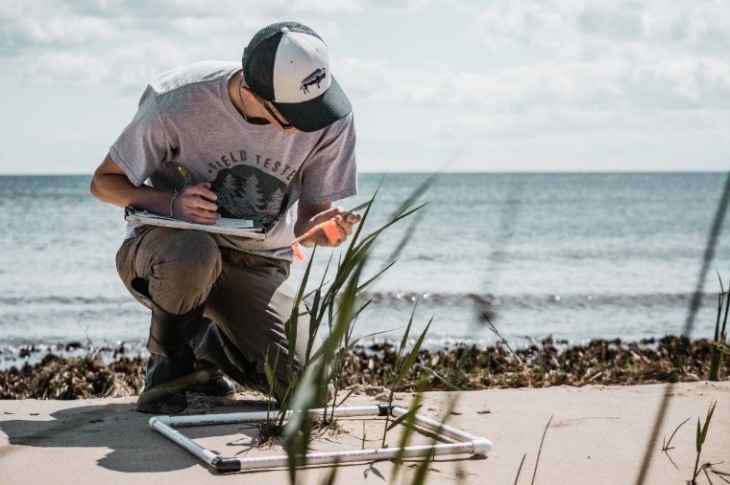June 29, 2018 – Etienne Herrick, USGS Great Lakes Science Center
With July right around the corner, it will soon be time to collect and submit monitoring data for your management units enrolled with PAMF. While monitoring may seem but one of many components of the adaptive management framework, don’t let its simplicity fool you – the standardized monitoring protocol and the data it produces help fuel collective learning across the Great Lakes basin.

A PAMF team member monitors invasive Phragmites using a 0.25 m2 quadrat, Vernier calipers, and a field sheet.
Central to any adaptive management program is the establishment of a well-defined objective, or desired ecosystem state. This objective then serves as the motivation behind future management actions as we try to continuously move closer to that desired state. However, in order to measure progress towards that goal, and ensure we reach it in an effective and efficient manner, we require some form of evaluation that can be repeated over time. Standardized monitoring protocols are an excellent way to do just that!
In the context of adaptive management, monitoring protocols are intended to capture the state of a particular resource or species of interest – in this case, the level of Phragmites infestation. When considered in conjunction with the set of management activities implemented between subsequent monitoring events, we can evaluate the effectiveness of those efforts for bringing us closer to our goal – the eradication of invasive Phragmites. This becomes an iterative process, where each round of management is followed by monitoring, which then produces data that is analyzed to measure progress toward our objective and inform the predictive model so that the management guidance it generates improves with each cycle. But, in order to maximize the utility of this fundamental process, we must ensure the parameters being used to gauge ecosystem or species response to management (i.e., the state of Phragmites infestation post-management) have been carefully chosen with consideration of some key factors and limitations.
First and foremost, the details of the monitoring protocol should be grounded in the purposes of monitoring and the way the resulting data will be analyzed. For PAMF, this meant developing a monitoring protocol that could effectively capture and track Phragmites infestation over time, and contribute to a science-based predictive model that guides future decision-making. It is crucial, however, to also consider potential constraints, like resource availability. Large-scale programs like PAMF require dedicated staff who are able to analyze monitoring data in a timely manner, which influences the types and amount of monitoring data that should be collected.
As with any citizen science effort, potential challenges from having such a broad pool of participants collecting and submitting data must be considered, too. Here, PAMF must strike a delicate balance between data quantity and quality. Given that the pace of learning proceeds much faster when data is generated by many people across many locations, it is in the best interests of PAMF and its participants that as many people monitor management units as possible. On the other hand, eliciting participation from individuals with widely variable skill and experience levels introduces greater opportunity for human error to interfere with data quality, which could not only slow the rate of learning, but even produce misleading evidence that supports less effective management activities. To address this issue, PAMF’s monitoring protocol is simple and straightforward, allowing for people from all backgrounds to participate, while still being comprehensive enough to effectively capture the state of infestation over time.
On a similar note, we often refer to monitoring as following a standardized protocol, which may seem like technical jargon, but is yet another critical aspect of PAMF and its ability to produce sound management guidance. Just as we need participants to be able to accurately collect data regardless of prior experience, we also need to ensure that everyone performs the monitoring protocol in the same way. For instance, if some participants measure stem diameter at the substrate, while others measure at the top of the plant, the data would be inconsistent and interfere with our ability to form conclusions. In other words, the data collected needs to be consistent and comparable across all management units enrolled in the program so that when we perform analyses for management action effectiveness, we know that all measurements for a given category are representative of the same thing.
We hope this explanation of standardized monitoring protocols and their role in adaptive management helps further illuminate the inner-workings of PAMF, as well as provides some context for the measurements and observations that we ask participants to collect. For more information about monitoring protocols, check out our resources on the PAMF Web Hub and on the Great Lakes Phragmites Collaborative website, or contact us at pamf@glc.org!
